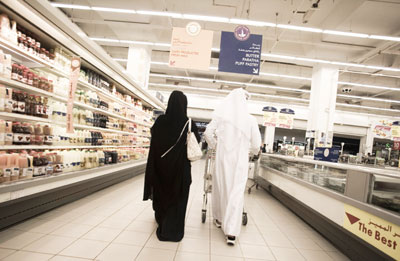
Saudi inflation edges up to 3.6pc on food costs
Riyadh, February 2, 2014
The Saudi inflation edged up in 2013, averaging 3.6 per cent in the first 10 months, mainly driven by higher food and housing costs, according to a report.
While food price inflation is expected to remain contained, pressures from residential rents could rise amid a shortage in affordable housing – a challenge that the government is trying to address through a house building program and new mortgage law, said a report by National Bank of Kuwait.
However, steady economic growth and softer food prices should keep inflation at a moderate rate of around 3-4 per cent over the forecast period, it stated.
NBK said the Saudi budget registered a lower, but still large, surplus of 7 per cent of GDP in 2013.
As oil prices slip further and revenues decline, the surplus is projected to continue to shrink to around 6-7 per cent of GDP in 2014 and 2015 – despite moderating expenditure growth, the Kuwaiti lender said in its report.
Further fiscal consolidation could conceivably affect capital spending allocations. Nevertheless, a large number of infrastructure projects – including major transportation and power projects – will be financed off-budget, thereby mitigating the impact of any curb in spending.
On the kingdom's financial scenario, NBK said the private sector credit growth has eased, but remains strong even as the stock market hits post-financial crisis peak.
Some financial indicators have shown a slight softening in market conditions: both credit and monetary growth have slowed from their peaks. But overall, the Saudi financial sector still looks in robust shape: banks are profitable and well-capitalized, lending growth is still strong and the stock market staged a significant rally in 2013, the report said.
According to NBK, solid economic growth and implementation of large government projects should provide continued support for the financial sector in 2014. Downside risks stem from a prolonging of the recent softening in private sector activity and possible instability in global markets.
"Growth in liquidity has eased somewhat in recent months. Annual growth in the broad money supply (M3) decelerated from a two-year high of 16 per cent in May 2013 to 10 per cent in October. Growth in the short-term measure M1 also slowed from 19 per cent in mid-2013 to an 11-month low of 15 per cent, as a result of weaker growth in demand deposits – which make up more than 60 per cent of total banking system deposits," it stated.
The Kuwaiti lender pointed out that the continuous flow of major infrastructure projects would provide Saudi banks with new lending opportunities going forward.
"Given the low interest rate environment and reliance on short-term deposit-based funding, Saudi banks have increasingly tapped the Islamic bond market as an alternative source of funds. This should support loan growth, and provide longer-term funding for large-scale projects and mortgages," he added.
Saudi banks’ balance sheets, said NBK, have continued to make significant gains.
"Commercial bank assets increased by 11 per cent y/y in the first ten months of 2013, driven by the continued rise in private sector claims. However, purchases of government securities have recently been growing at a much faster pace, and now account for 12 per cent of all bank assets, up from 10 per cent at the end of 2012," it added.
The Saudi stock market made significant gains in 2013, with the index reaching its highest level since the financial crisis. The market was up 22 per cent in the eleven months to November, led by strong growth in the tourism, retail, real estate and transportation sectors, said the NBK report.-TradeArabia News Service







